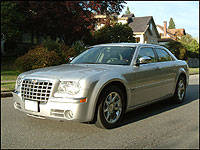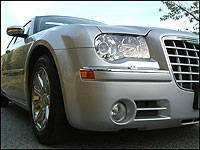The "Cool" HEMI Authority In Roman numerals "C" denotes a quantity of 100; in a
Chrysler 300 the letter "C" denotes a quantity of horsepower more than three
 |
| In Roman numerals "C" denotes a quantity of 100; in a Chrysler 300 the letter "C" denotes a quantity of horsepower more than three times that at 340. (Photo: Rob Rothwell, Canadian Auto Press) |
times that at 340, an impressive figure indeed - especially when backed-up by a torque rating of 390 pounds-feet! This palpitation inducing power is generated by a 5.7-liter (345 cu-in) HEMI V8, the likes of which we haven't seen since the Mopar heydays of the 1960s and '70s. If world conflicts, famine and plagues aren't enough to convince the skeptical that history repeats itself, utter the word "HEMI" and await an affirmation. During the horsepower wars that besieged the domestic auto industry during the decade of hippies and flower power, the phrase "426 Hemi" commanded awesome respect among performance enthusiasts and weekend racers. For 2005 that respect has returned to the automotive arena, once again under the tutelage of Chrysler. The original Hemi engine was unwrapped by Chrysler way back in 1951. It displaced 5.4-liters of atmosphere (331 cu-in) and milled out 180-horsepower, which some 53-years ago was hugely impressive. The Hemi legend culminated in 1965 when the power-drunk 426 hit the street, slamming out no less than 425 time-warping horsepower. So what's the Hemi's secret? Well for those too young to remember the '60s or those still recovering from them, "Hemi" refers to the hemispherical shape of the cylinder heads at the top of the combustion chambers. Each cylinder head is shaped like half a sphere; picture a tennis ball sliced
 |
| The secret to the HEMI's power is the hemispherical shape of the cylinder heads at the top of the combustion chambers. (Photo: Rob Rothwell, Canadian Auto Press) |
in two, place one of the halves pointing upward, atop a cylinder and - you get the idea. A Hemi design improves the air and fuel flow efficiency into the cylinder, the combustion of this mixture and the discharge of the exhaust it produces. Due to valve angle limitations, a Hemi engine relies exclusively on 2-valve per-cylinder technology; however the hemispherical shape of the head provides sufficient space to accommodate large, low restriction valves. To ensure a complete burn of the fuel during the combustion phase, Chrysler ignites the volatile mixture with two spark plugs per cylinder. The Hemi's leg-up on combustion efficiency translates into improved performance and power output, leaving many Hemi rivals sucking for air - literally.




